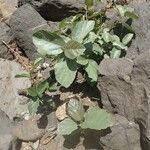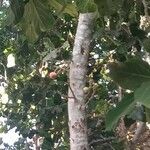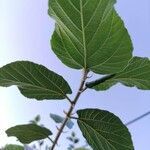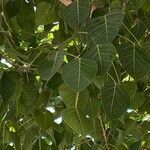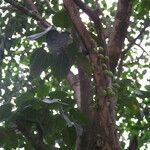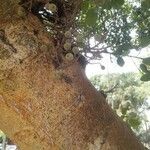Leaf lamina ovate to elliptic, or obovate to subcircular (1)2.5–12(21) x (0.5)2–11(16) cm., chartaceous to coriaceous, apex rounded to obtuse, base cordate sometimes obtuse, margin subentire, slightly repand or denticulate; superior surface scabrous to scabridulous, sometimes almost smooth or hispidulous to strigillose, the main veins whitish hirtellous to hirsute, inferior surface puberulous to hispidulous, the main veins sparsely whitish hirtellous to hirsute; lateral veins 5–10 pairs; petiole (0.5)1–4(6) cm. long, 1–3 mm. thick, densely, minutely white puberulous and with much longer white to yellowish hairs, with the periderm flaking off when dry; stipules 5–25 mm. long, white puberulous to tomentose or partly hirtellous to hirsute, caducous.
A fig. It is a deciduous tree. It grows to 13-25 m high and spreads to 14 m across. It has a rounded crown. The stem is erect. Sometimes the stem has buttresses. The base of the tree commonly spreads over the ground. The bark is yellowish. The leaves are olive green, oval or almost round. They are 5-12 cm long and 3-10 cm wide. The leaves are rough and leathery. They are hairy. The edge of the leaf is wavy and roughly toothed. The leaf stalk is 3 cm long. In dry seasons the tree may lose its leaves. The flowers are 2 cm across and roundish. The fruit are small and edible. They are 3 cm across. They grow in dense clusters in the axils of leaves or on main branches and on the trunk. The fruit are yellow-red when ripe.
Figs solitary or sometimes in pairs in the leaf axils or just below the leaves on unbranched, leafless branchlets up to 20 cm. long, or on branched, leafless branchlets up to 20(35) cm. long, or borne on the older branches down to the trunk; peduncle 3–25 mm. long, 1–3 mm. thick; basal bracts 2–3 mm. long.
Receptacle obovoid to pyriform or subglobose, often stipitate, at least when dry, 1.5–5 cm. in diam. when fresh, (1)1.5–3 cm. in diam. when dry, velutinous or densely tomentose to sparsely puberulous or pubescent, sometimes almost glabrous, yellowish to reddish at maturity.
Tree, up to 25 m high. Leaves ovate-rotund to elliptic, margin unevenly to irregularly scalloped, rough above, hairy beneath. Figs in densely branched clusters on main branches and trunk, stalked, 25-30 mm in diameter, softly hairy, pink to orange-red.
Leafy twigs 2–6 mm. thick, densely, minutely puberulous and with much longer, white to yellowish hairs, especially on the nodes; periderm flaking off when dry.
Tree up to 20(30) m. tall, trunk short, up to c. 2 m. diam., main branches spreading.
